The Musical Interval
Home » Complete Piano Chords Lessons » The Musical Interval
When speaking of chords we speak about harmony. Harmony is created by relationships.
As we continue to learn to play piano chords we will find that there are
various relationships between different chords.
But for now we're going to focus on the relationships between notes.
We can find the nature of the relationship between two different notes
according to the interval they create.
There are two kinds of musical intervals: Melodic intervals and harmonic intervals.
Melodic Intervals: When two notes appear one after the other they create a melodic interval.
A melody is basically a succession of melodic intervals arranged in a
certain musical shape that makes sense to us.
There's a nice piano lesson available on this subject in the beginners' piano course where I teach about the piano staff. Click here to follow the Piano Staff Lesson.
Harmonic Intervals: As opposed to melodic intervals which appear one after the other harmonic intervals are made of two notes which are played at THE SAME TIME.
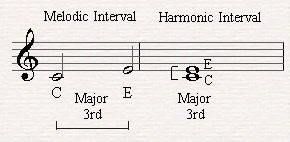
This audio file demonstrate a melodic interval followed by its harmonic twin.
If you can't read the notes only realise through the audio file that the notes in the melodic interval are played one after the other while the notes in the harmonic interval are played at same time.
The Musical Intervals Piano Lesson by pianoplayit
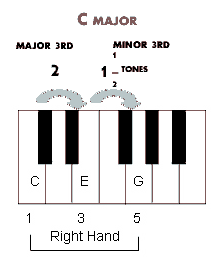
A Chord is a combination of 3 notes at least. You can also say a chord is a combination of two harmonic intervals. That's why I bother explaining all this to you.
By distinguishing the different intervals we will then be able to tell the names and kinds of the different chords.
So how are we going to measure the different intervals? We're going to count the number of half tones between two notes.
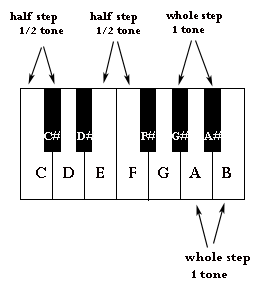
Half Steps (Semi-Tones) - The distance between each key and its closest upper
or lower key (whether it's a black key or a white one)
is half a tone which is the smallest interval used in Western music.
Notice that the distance between E and F and B and C is half a tone as well since there isn't a black key between them.
There's a piano scale called the chromatic scale which is made only from half steps. Click here if you wish to learn about this piano scale.
Whole Steps (Whole Steps) - A Whole tone then, is equal to 2 HALF STEPS with one key in between.
A Whole tone scale from example is a piano scale which is made only from whole tones. Click here to learn more about the Whole Tone scale. (And if you're not sure what piano scale are don't worry... we'll get to that as well)
Measuring Harmonic Intervals
Unison - When you play a note and then you repeat the same note you're
creating a melodic interval of unison (also called Prima in Italian).
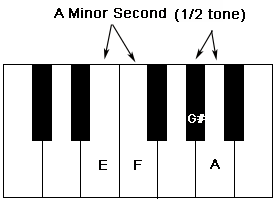
Minor Second - When you play a note and then play the next note half tone higher or lower (No matter if it's a white key or a black key) at the same time you play an harmonic interval of a minor second which sounds harsh.
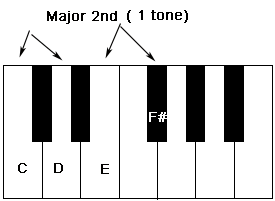
Major Second - When you play a note together with another
note which is located a whole tone higher or
lower (No matter if it's a white key or a black key) you play an harmonic
musical interval of a major second which sounds crowded but still warmer than a minor second.
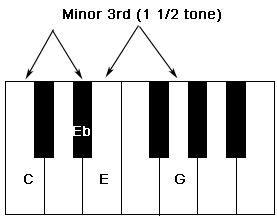
Minor Third - A distance one and a half tone between two notes creates an harmonic musical interval of a minor third which is considered to be mellow and sad in music.
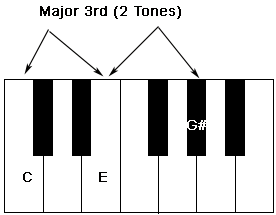
Major Third - The melodic major third interval is created by
playing two notes that share a distance of two tones from each other.
There are more musical intervals but theses ones here will help us to learn the basic chords we're going to cover in the near future.
If you'd like to expend your knowledge on musical intervals I suggest you click here for the full theoretical lesson on musical intervals where I demonstrate also how to recognize these intervals by ear.
And now let's move on to the next piano chord lesson where we're going to learn to play our first piano chord.
Return from the Musical Interval to the Complete Piano Chords Course.














